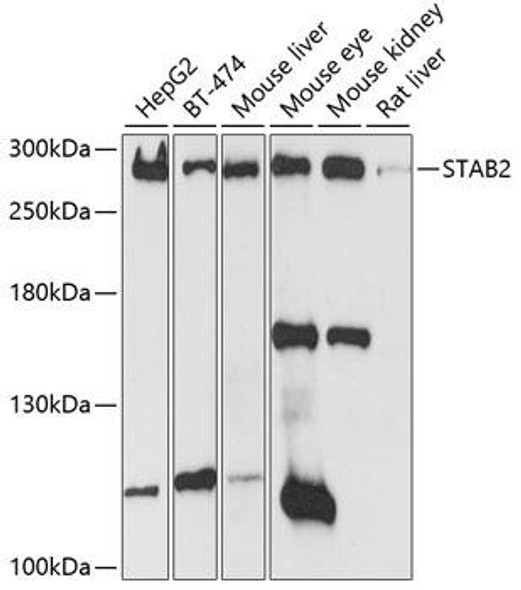Anti-CDC73 Antibody (CAB0636)
- SKU:
- CAB0636
- Product type:
- Antibody
- Antibody Type:
- Polyclonal Antibody
- Reactivity:
- Human
- Host Species:
- Rabbit
- Isotype:
- IgG
- Synonyms:
- CDC73
- C1orf28
- FIHP
- HPTJT
- HRPT1
- HRPT2
- HYX
Description
| Product Name: | CDC73 Rabbit pAb |
| Product Code: | CAB0636 |
| Size: | 100uL |
| Synonyms: | CDC73, C1orf28, FIHP, HPTJT, HRPT1, HRPT2, HYX |
| Applications: | WB |
| Reactivity: | Human |
| Host Species: | Rabbit |
| Immunogen: | Recombinant fusion protein containing a sequence corresponding to amino acids 435-505 of human CDC73 (Q6P1J9). |
| Applications: | WB |
| Recommended Dilutions: | WB 1:500 - 1:2000 |
| Reactivity: | Human |
| Immunogen: | Recombinant fusion protein containing a sequence corresponding to amino acids 435-505 of human CDC73 (Q6P1J9). |
| Purification Method: | Affinity purification |
| Storage: | Store at -20°C. Avoid freeze / thaw cycles. Buffer: PBS with 0.02% sodium azide, 50% glycerol, pH7.3. |
| Isotype: | IgG |
| Sequence: | Email for sequence |
| Gene ID: | 79577 |
| Uniprot: | Q6P1J9 |
| Cellular Location: | Nucleus |
| Calculated MW: | 60kDa |
| Observed MW: | Refer to figures |
| UniProt Protein Function: | CDC73: Tumor suppressor probably involved in transcriptional and post-transcriptional control pathways. May be involved in cell cycle progression through the regulation of cyclin D1/PRAD1 expression. Component of the PAF1 complex (PAF1C) which has multiple functions during transcription by RNA polymerase II and is implicated in regulation of development and maintenance of embryonic stem cell pluripotency. PAF1C associates with RNA polymerase II through interaction with POLR2A CTD non- phosphorylated and 'Ser-2'- and 'Ser-5'-phosphorylated forms and is involved in transcriptional elongation, acting both indepentently and synergistically with TCEA1 and in cooperation with the DSIF complex and HTATSF1. PAF1C is required for transcription of Hox and Wnt target genes. PAF1C is involved in hematopoiesis and stimulates transcriptional activity of MLL1; it promotes leukemogenesis though association with MLL-rearranged oncoproteins, such as MLL-MLLT3/AF9 and MLL-MLLT1/ENL. PAF1C is involved in histone modifications such as ubiquitination of histone H2B and methylation on histone H3 'Lys-4' (H3K4me3). PAF1C recruits the RNF20/40 E3 ubiquitin-protein ligase complex and the E2 enzyme UBE2A or UBE2B to chromatin which mediate monoubiquitination of 'Lys-120' of histone H2B (H2BK120ub1); UB2A/B-mediated H2B ubiquitination is proposed to be coupled to transcription. PAF1C is involved in mRNA 3' end formation probably through association with cleavage and poly(A) factors. In case of infection by influenza A strain H3N2, PAF1C associates with viral NS1 protein, thereby regulating gene transcription. Connects PAF1C with the cleavage and polyadenylation specificity factor (CPSF) complex and the cleavage stimulation factor (CSTF) complex, and with Wnt signaling. Involved in polyadenylation of mRNA precursors. Component of the PAF1 complex, which consists of CDC73, PAF1, LEO1, CTR9, RTF1 and WDR61. Interacts with POLR2A, CPSF1, CPSF4, CSTF2, MLL and CTNNB1. Interacts with a Set1-like complex that has histone methyltransferase activity and methylates histone H3. Found in a complex with BCL9L or BCL9, CDC73, CTNNB1 and PYGO1 indicative for the participation in a nuclear Wnt signaling complex. Found in adrenal and parathyroid glands, kidney and heart. Belongs to the CDC73 family. |
| UniProt Protein Details: | Protein type:Tumor suppressor; Cell cycle regulation Chromosomal Location of Human Ortholog: 1q25 Cellular Component: nucleoplasm; nucleus Molecular Function:protein binding Biological Process: negative regulation of myeloid cell differentiation; Wnt receptor signaling pathway; endodermal cell fate commitment; transcription, DNA-dependent; protein destabilization; stem cell maintenance; histone H2B ubiquitination; positive regulation of mRNA 3'-end processing; mRNA polyadenylation; negative regulation of transcription from RNA polymerase II promoter; cell cycle; histone monoubiquitination; negative regulation of cell proliferation; negative regulation of fibroblast proliferation; positive regulation of RNA elongation from RNA polymerase II promoter; positive regulation of transcription from RNA polymerase II promoter; positive regulation of Wnt receptor signaling pathway; negative regulation of epithelial cell proliferation Disease: Parathyroid Carcinoma |
| NCBI Summary: | This gene encodes a tumor suppressor that is involved in transcriptional and post-transcriptional control pathways. The protein is a component of the the PAF protein complex, which associates with the RNA polymerase II subunit POLR2A and with a histone methyltransferase complex. This protein appears to facilitate the association of 3' mRNA processing factors with actively-transcribed chromatin. Mutations in this gene have been linked to hyperparathyroidism-jaw tumor syndrome, familial isolated hyperparathyroidism, and parathyroid carcinoma. [provided by RefSeq, Jul 2009] |
| UniProt Code: | Q6P1J9 |
| NCBI GenInfo Identifier: | 74749063 |
| NCBI Gene ID: | 79577 |
| NCBI Accession: | Q6P1J9.1 |
| UniProt Related Accession: | Q6P1J9 |
| Molecular Weight: | Predicted Molecular Mass: 38kDaAccurate Molecular Mass: 38kDa |
| NCBI Full Name: | Parafibromin |
| NCBI Synonym Full Names: | cell division cycle 73 |
| NCBI Official Symbol: | CDC73 |
| NCBI Official Synonym Symbols: | HYX; FIHP; HPTJT; HRPT1; HRPT2; C1orf28 |
| NCBI Protein Information: | parafibromin |
| UniProt Protein Name: | Parafibromin |
| UniProt Synonym Protein Names: | Cell division cycle protein 73 homolog; Hyperparathyroidism 2 protein |
| Protein Family: | Cell division cycle protein |
| UniProt Gene Name: | CDC73 |
| UniProt Entry Name: | CDC73_HUMAN |







